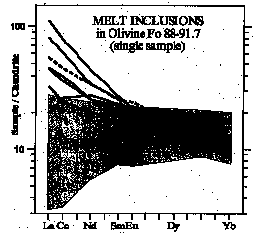
Recent studies of mid-oceanic ridge (MOR) primary melts reveal the evidence for occurrence of melts ultra-depleted by strongly incompatible elements which suggest very efficient melt extraction during melting of source mantle (Sobolev and Shimizu, 1993). Similar message came earlier from the ultra-depleted compositions of clinopyroxenes from MOR peridotites (Johnson et al., 1990). Both these data sets imply that MOR mantle is highly permeable for melt fractions of less than 1-3 % and thus predict the occurrence of melts originated by degree of melting of less than 1-3% of MOR mantle. Such melts must feature very significant enrichment by strongly incompatible elements over moderately incompatible elements together with primitive Mg number and were not so far reported at MOR. In this paper we report the discovery of melts which match these features. Such melts together with depleted ones were found as inclusions in high Mg olivine phenocrysts (Fo 88-91.7) in single EMORB sample from 14oN, Mid-Atlantic Ridge (see Fig. 1).
The studied sample came from the top of geochemical anomaly in MORB compositions occurs between 12 and 17oN (Bougalt et al., 1988; Sobolev et al., 1992). It consists of olivine and clinopyroxene phenocrysts and evolved matrix glass (Mg number 0.54) which features significant but not extreme enrichment in highly incompatible elements (K2O/TiO2=0.35; (La/Sm)n=2.2). Primary glassy inclusions in olivines were studied for major and trace elements contents by electron and ion microprobes correspondingly. The typical features of found ultra-enriched melts - UEM are as following: K2O/TiO2=0.7-1.0; (La/Sm)n=4.1-4.4; Zr/Y=8.7-9.6, reconstructed Mg number = 0.71-0.75.
Modeling suggests that observed UEM could originated as a result of critical melting of typical MORB mantle only at extremely low degrees of melting (0.3 wt.%) and low residual mantle porosity (0.3 wt.%) in the presence of significant amounts of garnet. The alternative possibility is that these melts were produced by incipient melting due to melt percolation through garnet bearing mantle column according to chromatographic model (Navon and Stolper, 1987).
Bougault, H., Dmitriev, L.V., Schilling, J.G. et al., Earth Planet. Sci. Lett. 88, 27-36 (1988).
Johnson, K.T.M., Dick, H.J.B. & Shimizu, N., Geoph. Res. 95, 2661-2678 (1990).
Navon, O. & Stolper, E., J. of Geol. 95, 285-307 (1987).
Sobolev, A.V., Dmitriev, L.V., Tsamerian, O.P. et al., Dokl.Akad.Nauk 326, 541-546 (1992).
Sobolev, A.V. & Shimizu, N., Nature 363, 151-154 (1993).
Fig. 1.